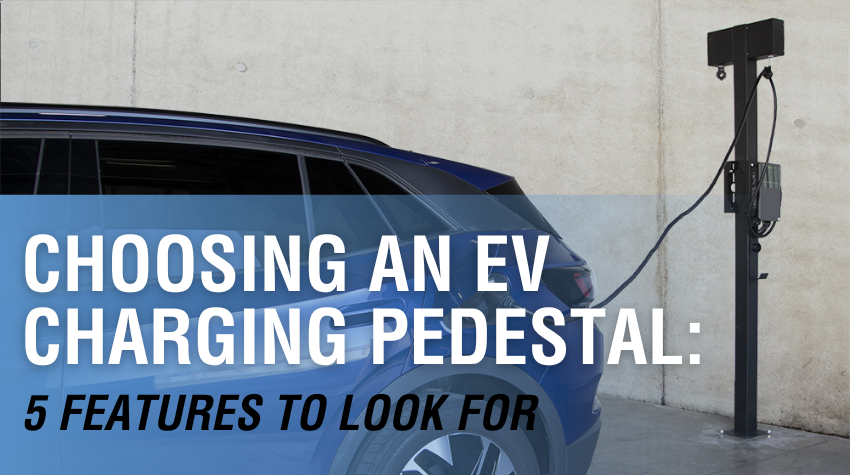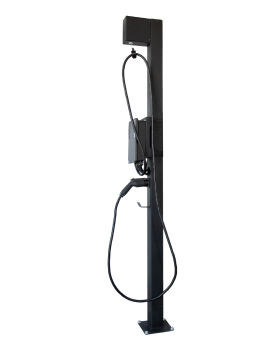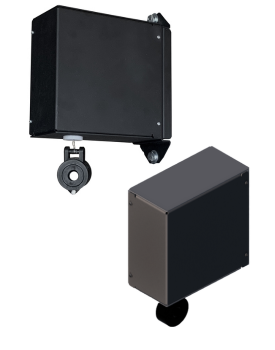We use cookies to make your experience better. To comply with the new e-Privacy directive, we need to ask for your consent to set the cookies. Learn more.
Choosing an EV Charging Pedestal: 5 Features to Look For
The United States Postal Service (USPS) is a top-three provider of local delivery services, lagging behind only FedEx and UPS. So when USPS invests in new transportation technologies, the whole industry takes notice.

Most recently, USPS has taken significant strides toward electrifying its fleet. In February 2023, the organization awarded contracts for over 9,000 electric delivery vehicles. Just as significantly, USPS also placed orders for over 14,000 EV charging stations.
The USPS purchases underscore a key challenge in broader vehicle electrification: Everyone needs more chargers. In a 2023 survey, 80% of adults said the lack of charging stations was preventing them from making their next vehicle electric. It’s reasonable to assume that the same calculus is playing out among fleet owners.
Luckily, there’s never been so much federal assistance available for EV charging stations, with the Bipartisan Infrastructure Law setting aside $7.5 billion in funding for this technology. And if you’re building your own fleet-charging station, you need more than the chargers themselves. You also need to plan for the infrastructure that supports those chargers.
The central structure in any EV charging station is the EV charging pedestal. Level 2 EV chargers are typically designed to be mounted onto walls or stands. If you plan on converting a parking lot or unenclosed depot into a charging area, you won’t have wall-space, which makes the charging pedestal your only option for storing, protecting, and granting easy access to each charger.
The market currently offers a wide range of EV charging pedestals at a variety of price points and levels of quality. How can you tell which one is right for your EV charging solution? Start by looking for these five essential features.
5 Key Features of the Ideal EV Charging Pedestal
We put these recommendations together for fleet owners, but they apply equally to all sorts of commercial fleets, small and large, from delivery vehicles to work trucks to company cars. Look for these elements when choosing a charger stand:
1. A Compact Footprint
Space is usually at a premium at any commercial facility. Choose charger stands that don’t require large footprints so you can devote that room to more useful purposes, whether that’s inventory or simply more parking.
In fact, a limited footprint is why we call them EV charging pedestals rather than charger stands. A stand might have multiple supports. A pedestal uses a single upright, and secures firmly to flooring or pavement, providing easy access to chargers without taking up too much room.
2. Support for Multiple EV Chargers
The other way to create space-efficient EV charging stations is to mount more than one charger per stand. Of course, you’re generally limited to two chargers per stand, simply because only two vehicles will fit within cable distance of the unit. Still, by doubling up on your pedestals, you can cut your number of installations in half.
3. Durable Construction
Charger pedestals have more than one job. First off, they must protect charging equipment. Secondly, they must elevate chargers to a suitable height off the ground (we’ll explain why in our fifth item on this list). Finally, they must make chargers simple and convenient to use. If you install them outside, they must also be weather-resistant enough to provide all these services in rain, snow, sleet, and sunshine.
Plastic EV pedestals won’t do the trick. Instead, look for EV charging stands built like industrial equipment: Welded steel construction with a weather-resistant powder coating. Durable charger pedestals will provide long, dependable service, sparing you replacement and maintenance costs across the equipment lifespan.
4. Integrated Cable Management Systems
Multiple standards and regulations call for the use of cable management systems with EV charging stands of all sorts, including pedestals. Even if that weren’t the case, cable handling tools make it a lot easier to use your chargers. They also help to prevent damage to cables, which are otherwise vulnerable to roll-over and internal damage from twisting and bending too much.
Ideally, your EV charger pedestal will have a pre-integrated system like an EV Charger Cable Retractor. These spring-loaded reels give way when a user pulls the cable out. Then they automatically retract the cable when charging is complete. Either way, your equipment stays safely out of harm’s way.
5. Compliance With NEC Article 625
The National Electrical Code (NEC) includes a chapter of standards about EV charging installations. Among other things, Article 625 of the NEC requires EV chargers to be placed at least 24 inches off the ground in outdoor installations. Inside, they must be at least 18 inches high.
At the same time, placing chargers too high can create accessibility issues, potentially violating the Americans with Disabilities Act. The U.S. Access Board recommends placing charger connectors and controls no higher than 48 inches above the floor or ground. This creates an ideal placement between 24 and 28 inches high for outdoor chargers, and from 18 to 28 inches high inside.
Article 625 of the NEC also requires the use of cable management systems for charging cables longer than 25 feet (7.5 meters). As we mentioned, however, shorter cables also benefit from these systems.
Where to Buy EV Charger Pedestals
So where can you find an EV charger pedestal that meets all these requirements? Right here at BHS, Inc. We’ve been designing vehicle charger stands and support equipment for forklifts since 1979, and we’ve applied those decades of experience to our line of EV Charger Handling Equipment.
Inquire about EV Charger Pedestals and Cable Management Kits from BHS, Inc. here, or call our sales team at 1.800.247.9500 to learn more.


